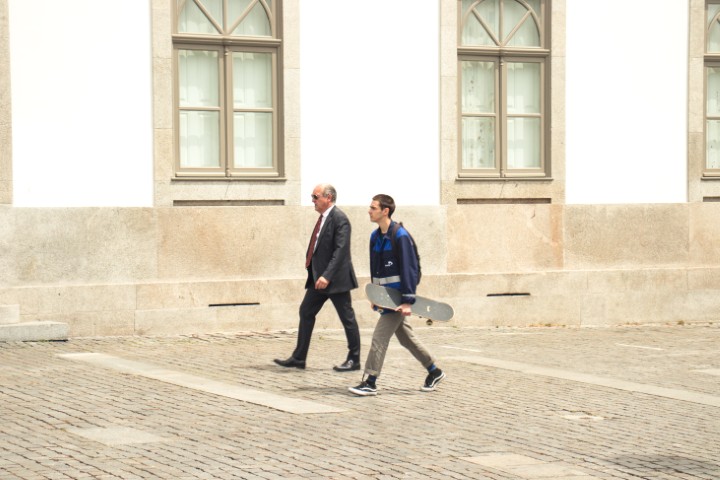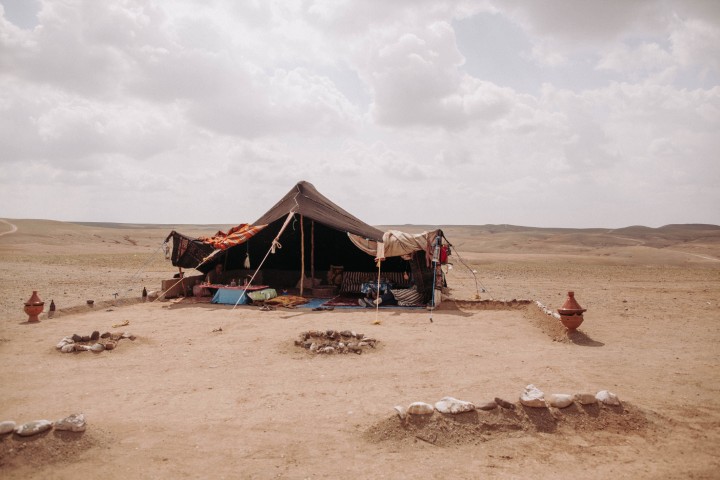
Modern life has often been defined by its need to reject the past in favor of a bold new future. In response, those embodying tradition have reacted in a coercive and authoritarian manner. This tension is at the heart of many of the conflicts that plague us today, but Judaism offers an alternative. The Passover seder represents a unique model in which fathers and sons join together in partnership, where past and future learn to live together in harmony.
Zachary Truboff
s
Among turn of the century Jewry there was perhaps no more beloved figure than Shalom Alecham’s Tevye the Milkman. Tevye’s jovial personality in the face of the harsh realities of shtetl life endeared him to many. However, much of Tevye’s popularity was driven by the way Shalom Aleichem insightfully depicted the many conflicts between tradition and modernity. Tevyeh represented an older more conservative generation struggling to make sense of a brave new world while holding fast to tradition. It was their children, nevertheless, who ran towards the opportunities that modernity presented them and did so in a manner that often caused great disappointment and sadness to their parents.In Fiddler on the Roof, the most famous adaptation of the Tevye stories, three of his daughters consciously reject the norms of traditional religious life causing great upheaval within the family. The choice of a marriage partner for each one of Tevyeh’s daughters reflects different ideologies and aspects of modern life that were unavailable to their father. Tzeitel, the eldest daughter, refuses her arranged marriage to an older widower and instead chooses to marry for love. Hodel, the middle daughter, marries an ardent communist who works for the eventual revolution and equality of mankind. Chava, the younger daughter, falls in love with a non-Jew and marries outside the faith.
In the late 19th and early 20th century, the cultural phenomena described by Shalom Alechehm exploded within the Jewish community. Children who grew up in deeply pious homes frequently turned their backs on their religious upbringing in order to embrace the freedoms of modern life. Nowhere was this tension more apparent than in the Zionist enterprise. Zionism offered the opportunity for young Jews to liberate themselves from what they perceived as an oppressive and backward tradition, in order to build a new and often secular Jewish identity for themselves in the Promised Land. A powerful example of the way in which Zionism rejected the past can be found in the writings of Hebrew poet David Shimoni. Subversively rewriting the verse from Mishlei (1:8), “Listen, my son, to the advice of your father, and do not abandon the teaching of your mother,” he writes:
My son, do not listen to your father’s advice,
Nor heed your mother’s teaching–
Because the father’s advice is only jots and tittles…
And the mother’s teaching is, “slowly, slowly, slow.”
But spring storms clamor, fierce and wild:
Listen, man, to the song of the child!
It was in this historical context that Sigmund Freud articulated his most important theory about the conflict between parents and children, based on the Greek myth of Oedipus. Oedipus is ordained by fate to kill his father and marry his mother. Even though both he and his parents attempt to avoid this destiny, the tragic outcome is inevitable. Freud’s analysis is primarily about the psychodynamics of child development and family life, but it also has great cultural significance. Ever since the Enlightenment, a central tenet of modernity has been the idea of Progress; the new must replace the old. Traditions which had been authoritative in the past were now discredited and viewed as relics of a bygone era. In traditional society, parents and elders were to be venerated, but modernity espoused a rebellious youth culture. In response, the older generation saw itself as having no choice but to impose its values on the younger one, leading to profound intergenerational conflict.
s
Judaism, however, presents an alternative model to the Oedipal conflicts that plague modern life. The paradigmatic example of which can be seen at the Pesach seder, a ritual which requires parents to tell the story of the Exodus to their children. It is this act, more than any other, which enables the mesorah to be passed down and creates a sense of shared identity that reverberates throughout generations past, present, and future. The Jewish parent is not meant to be a coercive patriarch who violently ensures Jewish continuity. Rather, he or she is perceived as a teacher, who has significant moral and religious obligations to their children. The seder night is meant to embody this model as parents act in various ways to arouse their children’s curiosity.
Children are not passive participants in what is taking place. The parent must engage the children in dialogue and inspire their questions. The role of teacher is without a doubt hierarchical as the teacher knows more than the student, but the teacher must also be willing to grant freedom to their students. Just as God must withdraw to make a space for creation, so too must the parent pull back and enable the child’s freedom to ask questions at the seder (Kedushat Levi, Vaykira). Though the parent child relationship may start as hierarchical, over time it gradually shifts. Teachers learn from the students as much if not more than their students learn from them.
Though this depiction of the seder may be beautiful, one still must question whether it is fully accurate. A closer look at the seder reveals that it too is not without its Oedipal conflicts. Does not the father’s exchange with the wicked son represent all of Freud’s concerns? The wicked son rebelliously challenges his father and seemingly denies the relevance of the seder by asking the following question, ‘What is this service to you?!.’ The father angrily responds with what might even be interpreted as an act of violence. He ‘blunts his teeth’ and tells the wicked son that if he had been in Egypt, he would not have been redeemed.
d
This back and forth may be unsettling, but it holds special significance for the modern orthodox community which struggles with its own Oedipal conflicts that have intensified in recent years. Caught between those who desire to change communal practice in order to accord with the times, and those who demand fealty to tradition and deference to rabbinic authority, the modern orthodox community often feels as if it is coming apart at the seams. Though both sides may be sitting at the same seder table, there is no guarantee that they will continue to do so in the generations to come. Like Tevyeh and his daughters, our current moment often leaves many in the modern orthodox community alienated from those who would be closest to us and as a result, the Jewish family and the Jewish people are deeply damaged.
In a beautiful essay, Rav Shagar notes many of these problems and attempts to offer a solution which he locates within the heart of the seder experience. He explains that traditional Jewish identity subsumes the ‘I’ within the ‘We’. Each member of the Jewish people sees themselves as connected to, responsible for, and part of the other. However,
…at a time when the ‘you’ is already present underneath the surface of the ‘we’, there is a need to develop a dialogue with the ‘you.’ It is necessary for speech to be liberated. This liberation is embodied in the ability for parents and children to speak to each other, something that is not possible for speech at the current moment… This can be aroused from the question: ‘Who is this person who is so close to me yet so far from me?’ This question may be asked from a place of alienation, but it is able to function as a springboard for deeper recognition and intimacy (A Time for Freedom, p. 130).
What exactly does it mean to liberate speech so that parents and children may encounter each other, and what insights might this offer to the modern orthodox community? While Rav Shagar does not fully clarify his words, it would seem that first and foremost, liberated speech requires parents and children to directly engage each other even at times when they viscerally disagree. The haggadah in fact already hints to this in the exchange between the father and the wicked son. It would have been all too easy for the father to throw his son out of the seder, as the Talmud itself notes that this has often been the response to a chutzpadik question asked in the beit midrash (Menachot 37a). Rather, the father gives his son an answer. A harsh answer, but an answer nonetheless. The son too must be given credit as well. He could have easily chosen not to attend. The very fact that he has come to the seder demonstrates his desire to be part of the Jewish family, even if he has yet to find his exact place within it.
d
There is a deeper level to the kind of liberated speech described by Rav Shagar, and it too can be found in the context of the seder. Parents tell their children the story of the Exodus through the vehicle of talmud torah, whose central feature is the asking of questions. Perhaps by asking the right questions, the space between parents and children can be bridged. Talmud torah is often known for its combative tone as chevrutah partners vigorously duel to prove their interpretation of the text is correct. In times such as our own, when we already feel alienated from each other, such an aggressive approach can lead to further polarization and disconnect. Instead, we need to recover a language that enables us to ask questions that open up the other, as opposed to shutting them down. Krista Tippet, a journalist who has spent years interviewing artists, writers, and religious thinkers, beautifully describes what is necessary in order for us to ask better questions. Similar to Martin Buber’s philosophy of I and Thou, she sees each conversation as an encounter full of radical possibilities. She explains that the first step is listening, something that appears to be a lost art in today’s day and age.
Listening is more than being quiet while the other person speaks until you can say what you want to say… It involves a kind of vulnerability- a willingness to be surprised, to let go of our assumptions and take in ambiguity. The listener wants to understand the humanity behind the words of the other, and patiently summons one’s best self and one’s best words and questions.
Deep listening requires us to acknowledge the image of God standing before us embodied in the other and leads us to ask questions that can open new paths of connection. The reality she explains is that Questions elicit answers in their likeness… it’s hard to meet a simplistic question with anything but a simplistic answer. It’s hard to transcend a combative question. But it’s hard to resist a generous question. We all have it in us to formulate questions that invite honesty, dignity, and revelation. There is something redemptive and life-giving about asking a better question (Becoming Wise, p. 29).
Though Krista Tippet is not Jewish, there may not be a more beautiful way to describe the power of Talmud torah than to see it as an activity that brings forth redemptive questions. If parents and children are able to approach each other not as opponents who threaten each other’s existence but as individuals, then such questions are possible. Such questions can transform the whole nature of the relationship and allow for dialogue and even intimacy where none existed in the past.
d
According to Malachi, the prophet Eliyahu’s job as a harbinger of redemption is to ‘bring together parents with children and children with parents’ (Malachi 3:24). According to the Talmud, it is said that Eliyahu will answer all the difficult halachic questions that remain unanswered since the times of Chazal. Maybe this will be achieved not through providing solutions but by helping us ask better questions. It is incumbent on all parts of the modern orthodox community to try to do just that. It may not be easy, and like the attempts to fix any damaged relationship within a family, it may not be successful. But there is no doubt that it is worth the effort.





